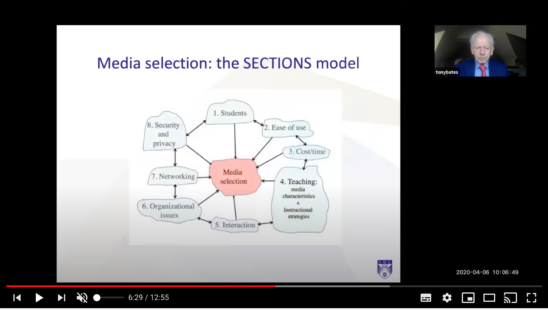The videos
At the request of the Commonwealth of Learning, I have, with their help, developed 12 short videos introducing the main themes of my open, online textbook, Teaching in a Digital Age.
These are now available from YouTube, as follows (click on each title for the url):
- Skills needed in a digital age (11 mins 39 secs)
- Online learning and teaching methods (9 minutes 58 secs)
- Implementing online learning (15 minutes 39 secs)
- Understanding the learners (12 mins 03 secs)
- Theories of learning (14 mins 30 secs)
- Learner support (15 mins 19 secs)
- Choosing media (12 mins 56 secs)
- Assessment strategies (20 mins 28 secs)
- Quality (8 mins 19 secs)
- Trends on open learning (11 mins 8 secs)
- Massive Open Online Courses (MOOCs) (9 mins 11 secs)
- Emerging technologies (13 mins 35 secs).
The plan
The Commonwealth of Learning (CoL) plans to make these available to their member states, and will also turn them into an open microlearning credential. (I will post further details when I receive them from CoL. In the meantime, click here for more information from CoL.)
However, CoL has also made the videos available as OER through YouTube.
Production and production standards
The original intention was to have these videos professionally produced at the facilities of the Commonwealth of Learning in Burnaby, British Columbia, but almost immediately after the decision was made to make the videos, we entered a lock-down because of the novel coronavirus.
As a result, the twelve videos were made in two days using my laptop at home and a Zoom link to the Commonwealth of Learning facilities, where post-editing was done.
Consequently both the design and the production quality are not what I nor CoL would have preferred. In particular the arrangement made it difficult for me to exploit the affordances of the medium – a key theme of the book, ironically.
Nevertheless the videos do provide a relatively short introduction to what is a large textbook (over 600 pages, with activities and appendices, if printed) and at the same time, the videos are freely available for anyone to use and give a good coverage of the main themes.
But as I say on the last video: the videos provide a summary of the content, but it is still necessary to read the book and do the activities to develop the skills needed to teach well in a digital age.










 Dr. Tony Bates is the author of eleven books in the field of online learning and distance education. He has provided consulting services specializing in training in the planning and management of online learning and distance education, working with over 40 organizations in 25 countries. Tony is a Research Associate with Contact North | Contact Nord, Ontario’s Distance Education & Training Network.
Dr. Tony Bates is the author of eleven books in the field of online learning and distance education. He has provided consulting services specializing in training in the planning and management of online learning and distance education, working with over 40 organizations in 25 countries. Tony is a Research Associate with Contact North | Contact Nord, Ontario’s Distance Education & Training Network.

